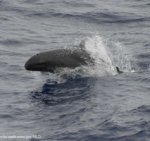 The False Killer Whale (Pseudorca crassidens) is one of the larger oceanic dolphins in the order of cetaceans. Its name indicates a resemblance with the much more widely known Killer whale or Orca. The False Killer whale, just like the orca, attacks and kills other cetaceans. Living in groups of 10 - 50 animals, the False Killer whale is a social animal, and a fast swimmer. It can grow to 6 meters in length, it can weigh as much as 1,500 kg and can live for about 60 years. The behavior and populations of the False killer whale have not been studied as intensively as the Orca, and the total population is unknown. For a range map click here.
The False Killer Whale (Pseudorca crassidens) is one of the larger oceanic dolphins in the order of cetaceans. Its name indicates a resemblance with the much more widely known Killer whale or Orca. The False Killer whale, just like the orca, attacks and kills other cetaceans. Living in groups of 10 - 50 animals, the False Killer whale is a social animal, and a fast swimmer. It can grow to 6 meters in length, it can weigh as much as 1,500 kg and can live for about 60 years. The behavior and populations of the False killer whale have not been studied as intensively as the Orca, and the total population is unknown. For a range map click here.
The False killer whale is listed as Least Concern (LR/lc), lowest risk. Does not qualify for a more at risk category. Widespread and abundant taxa are included in this category, on the IUCN Red List of Threatened Species
Namings for the false killer whale
A young / baby of a false killer whale is called a 'calf'. The females are called 'cow' and males 'bull'. A false killer whale group is called a 'gam, pod or herd'.Countries
Argentina, Australia, Brazil, Canada, Chile, China, Denmark, Ecuador, France, Germany, India, Indonesia, Iraq, Italy, Japan, Kenya, Malta, Mexico, New Zealand, Norway, Oman, Peru, Portugal, Russia, Saint Helena, Saint Vincent and the Grenadines, South Africa, Spain, Sri Lanka, Sweden, Taiwan, Tanzania, United Kingdom, United States, Uruguay and VenezuelaSome facts about the
False killer whale
Adult weight : 748 kg (1645.6 lbs)
Maximum longevity : 63 years
Female maturity :3468 days
Male maturity : 6756 days
Gestation : 451 days
Weaning : 730 days
Litter size : 1
Interval between litters : 1096 days

Custom Search